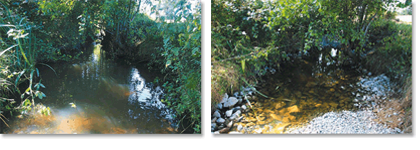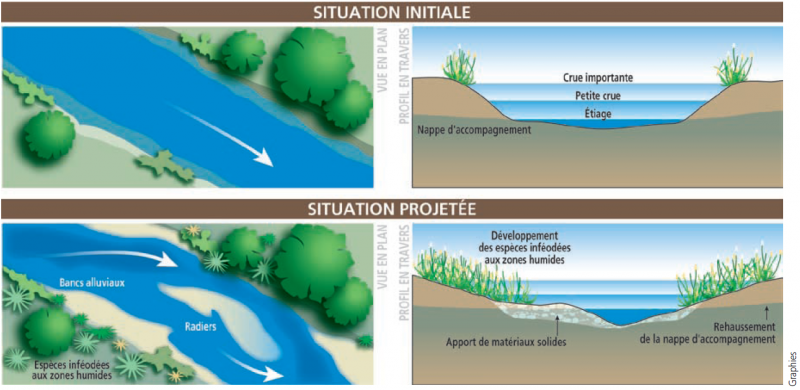Riverbed material represents the sediment eroded upstream, transported by the river and deposited on the river floor. It can be composed of coarse and/or fine material. Its re-naturalization consists in recovering the nature-like structure and composition of the bed load, in particular the equilibrium between coarse and fine sediment. In case of deficit of coarse sediment leading to river incision, the main objective is to level-up the riverbed with this type of sediment, by reactivating bank erosion in terrains contributing to this type of sediment. It should be noticed that in case of excess of fine sediment causing inundations, silting of hydro-electric dams or degradation of fish habitats, the main objective is to control erosion on slopes and riverbanks providing this type of sediment.
 |
Renaturalized riverbed, (France) Source: http://www.onema.fr/Les-jeudis-de-la-restauration,1432 |
 |
Explicative scheme for the principle of riverbed renaturalization (France) Source: http://www.syndicatdelaseiche.fr/entretenir-et-restaurer-les-cours/restaurer-le-lit-des-cours-d-eau/ |
| Benefits | Level |
|---|---|
|
PO1 - Improving status of biology quality elements
|
High
|
|
PO2 - Improving status of physico-chemical quality elements
|
Medium
|
|
PO3 - Improving status of hydromorphology quality elements
|
High
|
|
PO4 - Improving chemical status and priority substances
|
Medium
|
|
PO7 - Prevent surface water status deterioration
|
High
|
|
PO8 - Prevent groundwater status deterioration
|
Low
|
|
PO9 - Take adequate and co-ordinated measures to reduce flood risks
|
Medium
|
|
PO10 - Protection of important habitats
|
Medium
|
|
PO11 - Better protection for ecosystems and more use of Green Infrastructure
|
Medium
|
|
PO13 - Better management of fish stocks
|
Medium
|
|
PO14 - Prevention of biodiversity loss
|
Medium
|
|
ES1 - Water storage
|
Medium
|
|
ES2 - Fish stocks and recruiting
|
Medium
|
|
ES3 - Natural biomass production
|
Medium
|
|
ES4 - Biodiversity preservation
|
High
|
|
ES7 - Flood risk reduction
|
Medium
|
|
ES8 - Erosion/sediment control
|
High
|
|
ES9 - Filtration of pollutants
|
Medium
|
|
ES11 - Aesthetic/cultural value
|
Low
|
|
BP1 - Store runoff
|
Medium
|
|
BP2 - Slow runoff
|
Medium
|
|
BP3 - Store river water
|
Medium
|
|
BP4 - Slow river water
|
Medium
|
|
BP9 - Intercept pollution pathways
|
Medium
|
|
BP10 - Reduce erosion and/or sediment delivery
|
Low
|
|
BP12 - Create aquatic habitat
|
High
|
|
BP13 - Create riparian habitat
|
High
|
